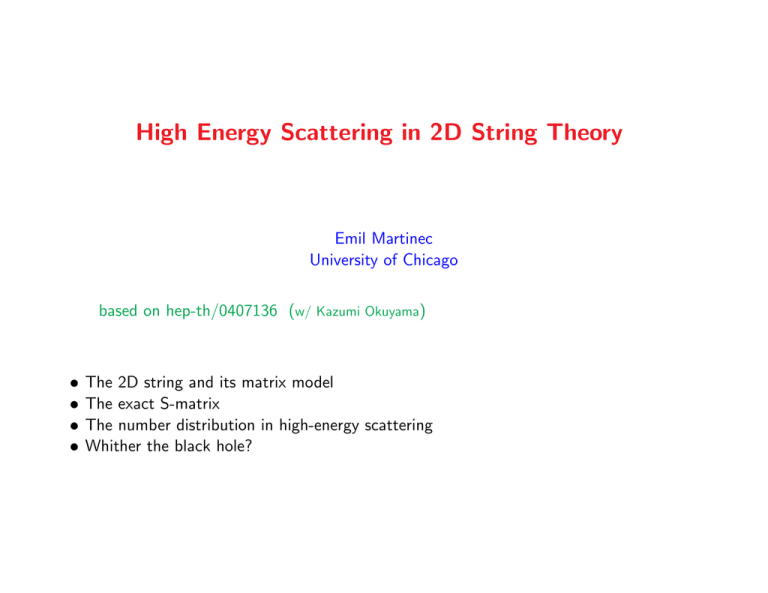High Energy Scattering in 2D String Theory
advertisement

High Energy Scattering in 2D String Theory
Emil Martinec
University of Chicago
based on hep-th/0407136 (w/ Kazumi Okuyama)
•
•
•
•
The 2D string and its matrix model
The exact S-matrix
The number distribution in high-energy scattering
Whither the black hole?
EJM 9/16/2004
Introduction
2D string theory illuminates two topics of recent investigations, providing
• A solvable example of open/closed string duality
• A laboratory for the study of tachyon condensation
The 2D closed string background
2
2
2
ds = dφ − dx
,
Φ = 12 Qφ ,
bφ
V = µe
,
with Q = b + b−1 = 10−D
, is a self-consistent perturbative string background at low
4α0
energy. The tachyon background is strongly coupled at high energy:
V
φ
weak coupling
strong coupling
1
EJM 9/16/2004
The model has an open string dual that controls the high energy behavior – large N
matrix QM on N unstable D0-branes (type 0B), or N D0-D0 pairs (type 0A). The open
string tachyon condensate on the decayed branes appears to realize the dynamics of closed
string worldsheets, neatly bringing together the two avenues of investigation.
The Gauss law of the open string gauge field projects the dynamics onto the U (N )
singlet sector of the matrix. The physical degrees of freedom are the matrix eigenvalues,
which behave as free fermions in an appropriate potential. The potential U (λ) in the
λ2
continuum limit is an inverted oscillator U (λ) = − 4α
0 for type 0B, and
λ2
q 2 − 1/4
U (λ) = − 0 +
4α
2λ2
for type 0A (q is the net D0 charge of the background). We focus on the type 0A theory,
in order to eliminate subtleties associated to the 2 → 1 map of λ-space to φ-space.
type 0A
µ
µ
type 0B
2
EJM 9/16/2004
High-energy scattering
What does high-energy scattering look like? The free fermions enable us to compute
the S-matrix exactly (Moore-Plesser-Ramgoolam 9111035).
The only physical state of the 2D type 0A string (at generic momenta) is the tachyon;
in the matrix formulation, the tachyon is a density wave on the Fermi surface
Vω = e
iω(x±φ) Qφ/2
e
†
⇔ δρ = δψ ψ ∼
1
2λ
e
i(x∓ω log |λ|)
The S-matrix is evaluated by LSZ reduction of correlations of fermion bilinears.
instance for 1 → N scattering
ω1
For
ω2
t
ωN
R*(−ξ)
R(ω−ξ)
λ
ω
3
EJM 9/16/2004
The scattering fermions pick up a phase in reflecting off the potential,
ψ(λ)
λ→−∞
∼
√1
πλ
h
i
−iλ2 /2+iω log |λ|
−iλ2 /2−iω log |λ|
e
+ R(ω)e
i.e. R(ω) is the reflection coefficient for the one-particle QM problem in the potential
U (λ):
2
−iω Γ( 1 + q + iω − iµ)
q
2
2
2
1
R(ω) = 4 − 16 + µ Γ( 12 + 2q − iω + iµ)
Holes pick up R∗(−ω). (Note that we measure energy w.r.t. the fermi level −µ.)
There are also “leg-pole” factors in the relative normalization of the worldsheet and
matrix model representatives of the asymptotic states
Vω =
Γ(+iω)
Γ(−iω)
δρ(ω)
we will consider quantities such as the number distribution in the final state, for which
these factors play no essential role. Note, however, that these factors are essential for
reproducing low-energy gravitational effects, such as the scattering of a tachyon from the
gravitational field produced by another tachyon (Natsuume-Polchinski 9402156).
4
EJM 9/16/2004
The 1 → N amplitude is thus
AN (ω|ωi) =
X
(−1)
|S|
Z
Pk
AN
l=1
∗
dξ R(ω − ξ)R (−ξ)
ωS
S⊂{1,···,N }
where ωS =
do the sum:
ω
ωjl and |S| = k for S = {j1, · · · , jk }. With a few tricks, one can
2
= q4 −
1
16
N
Y
dt
2itµ
G(t) e
2 sin(ωj t)
2t
−∞
j=1
Z
−iω
2
N −1
+µ i
∞
where G(t) is the Fourier transform of the reflection amplitude of the particle-hole pair
(so t is the time difference in the bounce of the particle vs. that of the hole)
∞
dν itν
e F
G(t) =
−∞ 2π
Z
ω−ν
2
F
ω+ν
2
,
F (ξ) =
q
Γ( 1
2 + 2 +iξ)
q
Γ( 1
2 + 2 −iξ)
5
EJM 9/16/2004
pω
√
The function G(t) is approximately constant for t . 1/ ω , with G(0) ∼
2π :
17.5
15
|G|
12.5
10
7.5
5
2.5
9
10
11
12
13
14
15
ω1/2 t
One of the physically interesting quantities we can calculate is the number distribution
PN of final state tachyons in 1 → N scattering, which is defined by
PN
1 1
=
N! ω
Z
0
N
∞Y
i=1
2
dωi X
δ
ωi − ω AN (ω|ωi) .
ωi
i
6
EJM 9/16/2004
For N of order a few, the integral for AN is dominated by the region where G is
constant; one can pull |G(0)|2 out of the integrals, and then compute them in closed form
with the result (we set µ = 0, in which case P2k ≡ 0)
P2k−1
(2π)2k−1(22k − 1)|B2k |
22k
∼
∼
(2k)! ω
ω
For N large enough that we can treat the final states statistically, we can approximate the
integral over the final state energies by saddle point, with hωii = ω/N . The saddle point
integral leads to
1 1
8 N
PN ∼
√
N! ω
π
To summarize, the number distribution for 1 → N scattering is peaked at Nmax ∼ log ω :
PN
log
ω
N
7
EJM 9/16/2004
Similar results apply for 2 → N scattering. There are two ring diagrams
ω2
ω1
ω1
ω2
t
t
ωN
ωN
R*(−ξ)
R*(−ξ)
R(ωa−ζ)
λ
R(ω−ξ)
λ
R(ωb−ξ)
R*(−ζ)
ωa
ωb
ωa
ωb
Consider for example both incoming particles of the same energy; for µ = 0 and N even
Z ∞
Z ∞
N
N
Y
Y
1
dt
ds
ω ω , ωi =
Gω (t)
2i sin ωl (s + t) −
2i sin ωl (s − t)
A2→N
2 2
π 0
t 0
s
l=1
l=1
X
Y
Y
Y
−
GωA ∗ GωB (t)
2i sin ωl (s + t) −
2i sin ωl (s − t)
(−2i) sin ωj s
A∪B={1,···N }
l∈A
l∈A
j∈B
R∞
Here f ∗ g is the convolution f ∗g(t) = −∞ duf (u)g(t − u). Qualitatively, this
amplitude will have a similar structure to the 1 → N amplitude. The k → N distribution
is also much the same – for N large enough that statistical methods apply, the probability
to find N particles in the final state is a steeply decreasing function of N .
8
EJM 9/16/2004
Black holes?
This result contrasts strongly with expectations from the low energy effective theory
of dilaton gravity. This theory has a 2D black hole solution
2
=
dφ ± tanh ( 12 Q φ) dx
Φ
=
Φ0 + log[cosh( 12 Q φ)] ,
ds
with Q2 =
2
k−2
2
2
2
= 4 (k = 5/2) for the 2D type 0 string. This background admits an
R)
exact worldsheet description as the SL(2,
gauged WZW model, and so naively is on as
U (1)
solid ground as the tachyon background described by Liouville CFT.1
Can one form black holes in 2D string theory? If black holes can form, they should be
the generic intermediate states due to their large density of states; they should dominate
the behavior of the S-matrix. The thermodynamics of such black holes is
SBH ∼ `sE
,
TH ∼ `s
1 The low-energy theory also has RR charged black hole solutions when q 6= 0; it is not known whether there is a corresponding
exact worldsheet CFT.
9
EJM 9/16/2004
The black hole thus emits its energy E in the form of quanta of string scale energy.
The expected number of emitted quanta would be
hN i ∼ `sE
which is not what is found in the exact S-matrix, whose number distribution is peaked at
hN i ∼ log E .
The reason that it is unlikely to find a large number of outgoing particles in the
scattering of a small, fixed number of high-energy ingoing particles stems from the basic
structure of the ring diagrams. For an initial state of k tachyons, the number of
particle-hole pairs in the intermediate fermion state is at most k. This state has a very
small overlap with an outgoing state
†
†
†
|outi = ψ ψ1 ψ ψ2 · · · ψ ψN |vaci
where in normal ordering the product of fermion operators we must select only those with
at most k particle and hole creation operators. This is a very small fraction of the totality
of excitations that can be created by this operator.
10
EJM 9/16/2004
This result suggests that black holes do not form in 2D string theory. In fact, many
aspects of 2D string theory indicate that there is nothing in 2D string theory that could
reasonably be called a black hole:
Entropy: Matrix quantum mechanics in the singlet sector does not have a Hagedorn
density of states. In many examples of the gauge/gravity correspondence, the formation
of black holes is associated with a deconfinement transition in the gauge theory, in
which one begins to access the non-singlet degrees of freedom of the gauge theory (e.g.
AdS5 × S5/N = 4 SYM). These degrees of freedom are projected out of the matrix
model of 2D string theory.
Conservation laws: The free fermionic character of the matrix model leads to an
infinite set of conserved quantities; the time-independent ones are
Z
` †
Q` = dε ε bεbε
where b, b† are fermion creation and annihilation operators. Sen (0408064) has argued
that the conserved charges of the 2D black hole are Q1 = ω, Q` = 0.
11
EJM 9/16/2004
States with these properties in the free fermion Hilbert space consist of a macroscopic
number of very soft tachyon excitations – more or less a coherent state of soft tachyons:
Q1 =
N
X
i=1
±ωi = ω
;
Q` =
N
X
`
±ωi ∼ o(N
1−`
),
`>1
i=1
The black hole charges are approached in the limit of large N . Since the phase space of
such states is not exponentially large, there is no reason for the evolution to be attracted
to such states as intermediate states. Furthermore, the process of soft tachyons making up
this state generating a Hawking quantum of energy ms is the time reverse of the process
of one energetic tachyon making many soft ones, which we argued above is kinematically
suppressed. The outgoing state will not look like Hawking radiation from a 2D black hole.
12
EJM 9/16/2004
The worldsheet CFT: The string scale curvature near the horizon of the dilaton black
hole geometry
2
=
dφ ± tanh ( 12 Q φ) dx
Φ
=
Φ0 + log[cosh( 12 Q φ)] ,
ds
2
2
2
points to the importance of an underlying exact CFT, the
SL(2,R)
U (1)
gauged WZW model.
The putative Euclidean black hole geometry is a capped semi-infinite cylinder often
referred to as the “cigar”:
curvature ~ Q
x
φ
13
EJM 9/16/2004
The background can be thought of as the nonlinear completion of the linearized
¯ of the metric away from flat spacetime. A shift in φ makes
deformation eQφ∂X ∂X
e−2Φ0 the coupling in front of the asymptotic graviton; as in higher dimensions, this
coefficient of the leading asymptotic deformation (of the time component G00 of the
metric away from flat spacetime) is the mass of the black hole µbh = e−2Φ0 .
A great deal is known about this CFT. There is a conformal bootstrap, analogous to
that of Liouville theory. In Liouville theory, one uses the two degenerate operators
V−b/2 = e
−bφ/2
,
V−1/2b = e
−φ/2b
to derive constraints on correlators which fix them uniquely. The analogous operators in
the coset are the degenerate primary operators Φj of SL(2, R) current algebra, having
spin j = − 32 and j = − k2 .
The coupling constant of Liouville theory is the parameter b. The theory is self-dual
under b → 1/b, which preserves the slope Q = b + 1/b of the linear dilaton, and
exchanges the two degenerate operators.
14
EJM 9/16/2004
R)
The Euclidean SL(2,
gauged WZW model also has a strong/weak coupling duality,
U (1)
but it is not self-dual. Rather, the dual is the Sine-Liouville theory
Z
h
1 φi
1
(2)
2
2
SSL =
d zd θ (DφD̄φ + DX D̄X) + QR φ + µsl cos R[Xl −Xr ] e Q
4π
2
where again Q2 = k−2
; X is compactified on a circle of radius R = 2/Q, and Xl −Xr
is the axial component of X . The conformal bootstrap for this theory yields the same
correlation functions as the coset model, and determines a relation µsl = µsl(µbh).
In a sense, the duality exchanges the roles of the asymptotic graviton interaction
1φ
Qφ
¯
Q
µbh e ∂X ∂X , and the Sine-Liouville interaction µsle cos R(Xl −Xr ). The metric
deformation is the dominant asymptotic (at φ → −∞) for Q 1, while the
Sine-Liouville coupling is dominant for Q 1. Since Q = 2 for the type 0 string, it
appears that the Sine-Liouville description is somewhat more appropriate for this 2D string
background.
Note that the Sine-Liouville potential acts as a generating function for vortices in
R)
the worldsheet partition function. The SL(2,
U (1) coset/Sine-Liouville equivalence leads to a
natural candidate for a matrix model equivalent to the Euclidean “black hole” – simply
turn off the Liouville potential and turn on a condensate of vortices (winding tachyon)
in the compactified Euclidean theory (Kazakov-Kostov-Kutasov 0101011). But again, the
matrix description of the background has a closer affinity to a tachyon condensate than a
Euclidean black hole.
15
EJM 9/16/2004
In higher dimensions, when the curvature of a black hole reaches string scale,
it undergoes a (correspondence) phase transition to a gas of strings. The apparent
dominance of the Sine-Liouville coupling is an indication that the “black hole” of 2D
string theory is actually on this other side of the correspondence point, where it is better
thought of as a gas or condensate of strings.
R)
If one considers the family of noncritical string backgrounds SL(2,
U (1) × CFTĉ , one can
vary Q by varying ĉ, Q2 = 4 − 12 ĉ. The Hagedorn temperature of a perturbative string
gas is
q
pert
βH = 2π ĉα0/4
while the Hagedorn temperature of the black hole geometry is given by the asymptotic
radius of the cigar
q
cigar
βH
= 2π
2α0/Q2
The two are equal when Q2 = 2, (k=3), which is precisely the point at which the
Sine-Liouville interaction starts to dominate. Thus the crossover between dominance of
the cigar metric and dominance of the winding tachyon condensate appears to be related
to the correspondence transition. In this regard, recall that the Hagedorn transition of
perturbative strings can be described as the condensation of precisely this winding tachyon
(Atick-Witten 1988).
16
EJM 9/16/2004
Conclusions
• The D-particles of 2D string theory dominate high energy scattering. Essentially, a
high energy incoming tachyon becomes a high energy D-particle, together with the
hole it leaves behind; radiation from the D-particle is strongly suppressed.
• The nonperturbative formulation allows an exact formulation of the S-matrix.
Estimates of the resulting integrals show that the number distribution is peaked around
N ∼ log ω outgoing particles.
• 2D dilaton black holes would give N ∼ ω outgoing particles.
• The 2D black hole is in a stringy regime. A variety of points of view suggest that
stringy effects dominate to the extent that black holes do not form.
17







